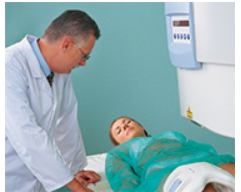
45-Year-Old Female with Dislocated Hip
Kayla Tanner, a 45-year-old mother of four, was involved in a car accident. When emergency responders arrived on the scene and extracted her from the car, they found that her right thigh appeared shorter than her left thigh. They also noticed that even slight hip movement caused considerable pain. Suspecting a hip dislocation, they stabilized and transported her.

In the emergency department, doctors discovered a decreased ability to sense light touch in her right foot, and she was unable to move her toes or ankle. Dislocation of her right hip was confirmed by X ray. Mrs. Tanner was sedated to relax the muscles around the hip. and then doctors placed her in the supine position and performed a closed reduction (“popped” the femur back in place).
5. NCLEX-STYLE Mrs. Tanner is discussing her injury with you during recovery. Which of her remarks indicate a need for additional education about her injury?
a.“I dislocated my shoulder twice. I guess this hip injury is just the same sort of thing–I’m surprised it hasn’t happened before. I’m sort of nervous that it could just slip out any time!”
b.“I didn’t realize that so many of the hip bones were fused together.”
c.“The bottom of my spinal column is really different from the top!”
d.“When you look at how tight those connections are, it’s easy to see why I can’t move my leg around at the hip the way I move my arm around at the shoulder.”
Want to see the full answer?
Check out a sample textbook solution
Chapter 7 Solutions
Human Anatomy & Physiology Plus Mastering A&P with Pearson eText -- Access Card Package (11th Edition) (What's New in Anatomy & Physiology)
- If you wanted to reduce the difference between peak and trough levels that occur with repeated administration of a drug, how would you adjust the dose and dose interval without changing the plateau concentration (plateau is the average of peak and trough levels)? Select your answers for both dose and interval. Hint: It may be helpful to think about this problem using an example such as food. How would you eat if you wanted to maintain very steady hunger/satiety levels without changing your total caloric intake? Options: A. Dose; Increase dose B. Dose; Decrease dose C. Dose; Do not change dose D. Interval; Increase the interval between doses (give the drug less frequently) E. Interval; Decrease the interval between doses (give the drug more frequently) F. Interval; Do not change the intervalarrow_forwardWhat percentage of a drug is eliminated after 4 half-lives? Please round to the nearest percent. Show the matharrow_forwardBriefly explain the 6 domain of interprofessional collaboration: Role clarification, Team functioning, Interprofessional communication, Patient/client/family/community-centered care, Interprofessional conflict resolution, Collaborative leadership. Provide a specific negative events that nursing student would observe in a clinical setting for each domain.arrow_forward
- what is an intermittent water course and what kind of fish habitat it would providearrow_forwardwhy are native freshwater mussels are an important part of great lakes ecosystemarrow_forwardwhat morphological features differentiate the lamprey species and other species in the great lakesarrow_forward
- There are a wide range of therapeutic applications available as options for patients. Medical professionals should be aware of these applications so they can make informed recommendations to patients. To gain a better understanding of some therapeutic applications and how they are related to RNA and mRNA, research long non-coding RNA. Respond to the following in a minimum of 175 words: What is lncRNA and what does it do? How does IncRNA differ from mRNA? What are some therapeutic applications associated with lncRNA? Think about possible future uses of this application. What are the advantages and disadvantages of this application and its continued use?arrow_forwardfour fish or mussel species that are native to the great lakesarrow_forwardThere are a wide range of therapeutic applications available as options for patients. Medical professionals should be aware of these applications so they can make informed recommendations to patients. To gain a better understanding of some therapeutic applications and how they are related to RNA and mRNA, research long non-coding RNA. Respond to the following in a minimum of 175 words: What is lncRNA and what does it do? How does IncRNA differ from mRNA? What are some therapeutic applications associated with lncRNA? Think about possible future uses of this application. What are the advantages and disadvantages of this application and its continued use?arrow_forward
- four physial characteristics of a fish or a mussel that would help you identify it to a speciesarrow_forwarddescribe what you would do in this situation, you are working ona. river and it will take 20 minutes by boat to get back to the field truck, you are 1 hour from finishing the field work on the last day of field trip. you hear thunder int he dsitnace, what did you do?arrow_forwardunu grow because auxin is still produced in the tip to Another of Boysen and Jensen's experiments included the use of mica, explain why one of the shoots was able to show phototropism and the other was not. Mica Wafer Ligh c. They then t but this time permeable n shoot. Why phototropis Light Mica Wafer Coleoptile tips Tips removed: agar Explain why the shoo direction after the ag the cut shoot, even tarrow_forward
- Surgical Tech For Surgical Tech Pos CareHealth & NutritionISBN:9781337648868Author:AssociationPublisher:Cengage
 Medical Terminology for Health Professions, Spira...Health & NutritionISBN:9781305634350Author:Ann Ehrlich, Carol L. Schroeder, Laura Ehrlich, Katrina A. SchroederPublisher:Cengage Learning
Medical Terminology for Health Professions, Spira...Health & NutritionISBN:9781305634350Author:Ann Ehrlich, Carol L. Schroeder, Laura Ehrlich, Katrina A. SchroederPublisher:Cengage Learning - Essentials of Pharmacology for Health ProfessionsNursingISBN:9781305441620Author:WOODROWPublisher:Cengage





